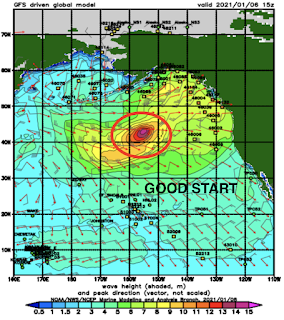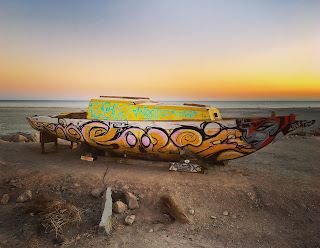Y'all ready for this?
SURF:
It took awhile but if you didn't notice, winter is finally here.
Heaps of surf the past month has finally been met with rain and mountain snow. As you've probably heard by now, we'll have a legitimate storm roll through Southern California tonight.
As it does, today's swell will be blown to bits and the water this weekend? Dirty as Al Capone. Saturday will be sunny with NW wind, while Sunday should have cleaner conditions and small NW swell- but it won't be worth going out anyway due to the small swell and filthy water. Here's the tide, sun, and water temps anyway:
- Sunrise and sunset:
- 6:44 AM sunrise
- 5:20 PM sunset
- Water temps are floating around 57 due to the strong NW winds earlier this week. Just be glad you're not surfing San Fran this week where water temps are 51.
- And tides have quite a swing this weekend- might be good to check out the tidepools with the kiddos:
- 4' at sunrise
- 6.5' at mid-morning
- -1.1' late afternoon
- 1' at sunset
FORECAST:
The general rule of thumb is to not surf after it rains until 72 hours have passed. So when Friday's rain exits the region, Saturday/Sunday/Monday would be our 72 hour window and that would mean by Tuesday we could surf again! That's IF... there wasn't another low pressure system rolling through Southern California on Tuesday.
This one doesn't look to be too wet or windy but just enough to screw up a new shoulder high+ NW swell.
And as luck would have it, there's an early season waist to chest high SW arriving late Monday that will also get chopped up by the cold front Tuesday. So is there any good news? Looks like high pressure MAY set up late next week and push the storms towards the Pacific Northwest.
We could see a fun WNW around the 6th of February- and clean conditions as well.
Charts also show another early season SW taking shape next week which could give us fun chest high surf around the 11th. Make sure to check out Twitter/North County Surf if anything changes between now and then.
BEST BET:
Maybe late Monday if that small SW shows (and before the rain on Tuesday). Or next weekend with new WNW and potentially clean conditions.
WEATHER:
Be glad you're not in Central California today as the atmospheric river is bombarding the coastal slopes. Rain gauges since midnight have recorded 12-14" so far. Not much weather for us down here today- but it's coming. If you don't get woken up tonight from the pounding rain, you'll definitely will by Friday morning. Luckily for us, the bulk of the precipitation will stay to the north but we will see 1-2" along our coasts and valleys while the So-Cal mountains will see close to 2' of snow above 7,000'. Winds won't be particularly strong with this storm (compared to Monday where winds blew 50-60 mph along the coast), but we'll still see gusts from 25-30 mph. Saturday we'll have sunny skies and a NW breeze and Sunday will be sunny and cool. Monday looks to be the same and then our next (weaker) system moves through. After that, we should have sunny cool conditions the 2nd half of next week. As far as our rain total goes, after tomorrow's big storm, we may still only be at 2/3 of where we should be. Hope there's more to come this season.
NEWS OF THE WEEK:
NEWS OF THE WEEK:
You've probably seen the news this week about the 'atmospheric' river taking aim at California today. In simplest terms, think of a low pressure system looking like a wheel. During a normal storm, the wheel would roll right over us. In an atmospheric river, the 'wheel' spins in place and keeps dumping rain. That's what's happening in San Luis Obispo County today as they've received over 1' of rain (not snow I said, rain), and the Sierras could get up to 10' of snow. Sounds awesome if you're visiting- awful if you live in it. Here's an article from the Washington Post this week to shed light on this atmospheric river:
A major West Coast storm continues to dump heavy rains and feet of mountain snow in California, as the low pressure area taps into a corridor of ultra-moist air known as an atmospheric river. The storm has led to mudslides in Monterey County, with continued concerns about the stability of lands in and around burn scars from recent wildfires. Meanwhile, in the Sierra Nevada Mountains, blizzard conditions continue, and several more feet of snow are possible before the storm finally pulls away from the region late Friday. In Monterey County, at least two people were injured and 50 horses rescued after fast-moving mud and debris from the River Fire burn scar smashed into homes. Numerous flash flood watches remain in effect throughout the San Francisco Bay area, with the greatest risk of flooding on Thursday shifting slowly southward with time. According to the National Weather Service forecast office in San Francisco, the heaviest rain has fallen in southern Monterey County — 9.45 inches as of early Thursday — and rain continues to fall.
A strong atmospheric river such as this event can transport an amount of water vapor that’s about equivalent to 7.5 to 15 times the average flow of water at the mouth of the Mississippi River, according to the National Oceanic and Atmospheric Administration. The heaviest rain is expected to focus south of San Francisco throughout the day, closer to Santa Cruz and Santa Clara, as the storm system responsible for the wintry mess digs further to the south. Similar shifts are expected with the areas of heaviest snowfall, as snowfall rates of two to three inches per hour in the Tahoe Basin ease up, and blizzard conditions migrate south during the day. Blizzard warnings are in effect for the central Sierras through early Friday morning, and even if snowfall rates diminish in the Tahoe region, additional accumulations are still expected there. “We also can’t rule out pockets of thundersnow with this storm,” the Weather Service said in an online forecast discussion.
Widespread snow totals of more than five feet were expected from the fire hose of moisture aimed at the tall peaks of the Sierra Nevada Mountains. Mammoth Mountain had already picked up an estimated four to six feet as of early Thursday, according to the National Weather Service in Reno. An additional three to four feet was forecast by Friday afternoon, bringing isolated totals to 10 feet. Images captured at the Mammoth Mountain Ski Area in Mammoth Lakes revealed visibilities down to barely 200 feet. In the highest elevations, the excessive snowfall rates of up to four inches per hour were combining with winds topping 75 mph to produce whiteout conditions. “If you risk travel over the Sierra passes, you could be stuck in your car for many hours,” warned the Weather Service in Reno, stating that wind chills could dip to 20 degrees below zero.
Meanwhile, the increasingly unstable snowpack is prompting avalanche concerns, and the Eastern Sierra Avalanche Center issued a backcountry avalanche warning for parts of the central Sierra Nevada along Highway 395. That highway was shut down overnight Wednesday from near Bishop, Calif., to the Nevada state line, and was expected to reopen on Thursday.
The extreme snowfall is reminiscent of a storm on Dec. 19-20, 2010, which dropped a whopping nine to 13 feet of snow atop Mammoth Mountain. Mammoth Mountain’s main lodge is at roughly 9,000 feet elevation, the summit towering to 11,053 feet. The altitude of the mountains in the Sierra Nevada is instrumental in their prolific snows, since they force the air, which is carrying extremely high levels of moisture, to rise, cool and condense, which results in a dramatic increase in precipitation rates. Such mountain-induced precipitation patterns are known as orographic enhancement. On average, Mammoth Mountain sees about 17 feet of snow per year. Snow in the Sierra is expected to taper down by Friday afternoon.
California has been mired in a deepening drought, with wildfires igniting in Northern and Southern California earlier this month. The whiplash between extremely dry conditions and heavy rains is an example of a weather pattern shift that climate scientists expect to occur more frequently as the region continues to warm.
The extreme snowfall is reminiscent of a storm on Dec. 19-20, 2010, which dropped a whopping nine to 13 feet of snow atop Mammoth Mountain. Mammoth Mountain’s main lodge is at roughly 9,000 feet elevation, the summit towering to 11,053 feet. The altitude of the mountains in the Sierra Nevada is instrumental in their prolific snows, since they force the air, which is carrying extremely high levels of moisture, to rise, cool and condense, which results in a dramatic increase in precipitation rates. Such mountain-induced precipitation patterns are known as orographic enhancement. On average, Mammoth Mountain sees about 17 feet of snow per year. Snow in the Sierra is expected to taper down by Friday afternoon.
California has been mired in a deepening drought, with wildfires igniting in Northern and Southern California earlier this month. The whiplash between extremely dry conditions and heavy rains is an example of a weather pattern shift that climate scientists expect to occur more frequently as the region continues to warm.
PIC OF THE WEEK:
Our water temp? 57. Their water temp? 82. Our conditions tomorrow? Onshore mess. Theirs? Lightly groomed offshore winds. And don't even ask me about crowds. Know of anyone that will let me crash at their pad in the Caribbean for a few months?
Keep Surfing,
Michael W. Glenn
Popular
Cashing Out My Bitcoin And Putting It In Gamestop
Was Developing An Organic Wax Made Of Beeswax Until My Lab Was Broken Into By Bears




















































